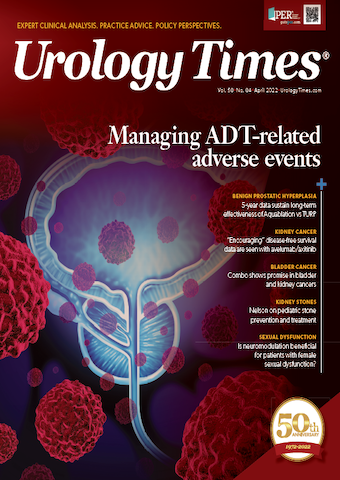Publication
Article
Urology Times Journal
Managing ADT-related adverse events: An expert’s view
Author(s):
"It’s important to recognize that there has been a shift in the way we approach ADT," says David F. Jarrard, MD.
David F. Jarrard, MD

Androgen deprivation therapy (ADT) is a mainstay treatment for prostate cancer, but it comes with adverse effects including bone density loss, hot flashes, cardiac risks, and others. In this interview, David F. Jarrard, MD, discusses new data regarding adverse events and how they are best managed. Jarrard is a professor and vice chair of urology and the John P. Livesey Chair in Urologic Oncology at the University of Wisconsin School Of Medicine and Public Health, and an associate director at the University of Wisconsin Carbone Cancer Center in Madison.
What factors influence your choice of ADT?
There are a number of considerations. It’s important to remember that there are several different “flavors” of ADT. These include gonadotropin-releasing hormone [GnRH] agonists and antagonists. There are also androgen receptor blocking agents, but as monotherapy, they’re less commonly used.
There is also the mode of administration to consider. Some of these are injections. There is now an oral agent, relugolix [Orgovyx], which is a GnRH antagonist. Another option is orchiectomy. Another aspect to consider is whether this is continuous ADT or is it going to be intermittent? Intermittent is somewhat easier with oral administration or some of the shorter-acting injectables. Finally, safety and adverse events are considerations that may modulate the use of different approaches.
How does the duration of ADT influence your choice of therapy?
The oral agents are fast acting and can be used acutely. In addition, if one is thinking about a length of time for ADT, these can be cycled on and off relatively easily. When you’re looking at efficacy between these GnRH antagonists and agonists, they’re both effective. The recent HERO trial [NCT03085095] looked at relugolix vs leuprolide acetate. In this study, they looked at 1-year outcomes with regard to efficacy; namely, castration rate or testosterone less than 50 ng/mL.1 There was noninferiority—and even superiority—when comparing relugolix vs leuprolide acetate. It should be noted that castrate levels occur very rapidly with these GnRH antagonists, and castrate levels of testosterone occur at 4 days in about half of patients. With leuprolide acetate, there’s a spike in testosterone that occurs and so those patients are not castrate at that early point. In terms of cycling and length of time, the immediate need for ADT suppression is generally better handled with these GnRH antagonists.
What are the most common adverse events of ADT, and how do you manage them?
Hot flashes are something that occur commonly in patients. We have several newer options with regard to drug therapy, including venlafaxine and gabapentin, that can be utilized for these patients. Osteoporosis is another adverse event. Patients often feel fatigued, [although] routine exercise can help mitigate that to a certain extent. There are also issues such as metabolic syndrome, decreased libido, and erectile dysfunction. Cardiovascular disease is one that’s [received] increasing attention more recently as well.
When you think about some of these adverse events, with regard to some of the metabolic consequences, there’s weight gain, dyslipidemia, and loss of lean muscle mass. Some of the strategies for [treating] these patients include getting a dietitian involved. Again, exercise is important. And it’s important in these older patients to assess their fall risk with regard to making sure that treatment doesn’t make them even [more] frail. And finally, diabetes management is important with regard to metabolic adverse events.
There are a number of skeletal-related adverse events that also occur, including a decrease in bone density. It’s important to assess bone density status prior to receiving ADT. That would include a DEXA [dual-energy x-ray absorptiometry] scan, which should be repeated every year or 2. Blood tests for calcium, creatinine, and vitamin D are also important in assessing men before they enter or begin ADT and even during their course.
Another aspect we’ve become more aware of in the modern era is the need for cardiovascular assessment. In patients receiving ADT, there was a warning added to leuprolide acetate, in part because of concerns over worsened cardiovascular outcomes. Indeed, the American Urological Association [AUA] in 2010 recommended evaluation of cardiovascular risk factors prior to patients being started on ADT, looking at hypertension, lipids, blood glucose, and other related features. There have been a number of meta-analyses of the cardiovascular effects of ADT. One issue is many of the randomized controlled trials looking at ADT approaches aren’t really powered to look at cardiovascular adverse events. One way of getting around that is to use meta-analyses. When one looks at these studies, they have demonstrated associations between ADT and an increased risk of cardiovascular events, as well as death. That is something to keep in mind with regard to those patients starting ADT.
How much do cardiovascular adverse events affect patients in your clinical practice?
Because we deal with an elderly population, cardiovascular risk is often significant. In many trials in which patients are evaluated beforehand, roughly 50% of the patients entering into [them] will have cardiovascular risk factors. It is important to undertake this kind of assessment, in conjunction with a primary care doctor, or even a cardiologist if need be.
What impact does ADT have on cognition, and how do you manage it?
It’s been something we’ve suspected for a long period of time, and emerging research has suggested that ADT may be associated with cognitive impairment. This can in turn be linked to a loss of independence, increased falls, fracture risk, and other aspects. When looking at specific aspects of cognitive dysfunction, this includes things like memory and visual-motor function. The big question, obviously, is how do you mitigate this. That’s an area that’s ripe for research. There certainly are some potential links between exercise and improved cognitive function, but further studies are needed to confirm that and other approaches.
What impact does ADT have on libido, and how do you manage it?
That’s one of the more problematic areas with regard to ADT. With the vast majority of these drugs, you’re decreasing testosterone, and that clearly has an effect on libido. With androgen receptor blocking agents, these first-generation ones like bicalutamide [Casodex], you don’t see the decrease in testosterone as a single agent. However, due to the reduced efficacy and adverse events, these agents are not recommended by guidelines panels as monotherapy. Exercise may mitigate this, but it is an area that needs more research. Intermittent ADT may be an option for selected patients, giving individuals periods of time without testosterone suppression.
Which type of patient is intermittent ADT recommended for and when should ADT be started?
It’s important to recognize that there has been a shift in the way we approach ADT. In the past, for patients that have essentially exhausted all their treatment options and failed primary treatment with a rising [prostate-specific antigen (PSA) level], the current recommendation by the AUA and other guidelines is observation. It’s often a challenge because the patients are nervous, the families are nervous, and even the physicians can be nervous. In situations like this, clinical trials are one option. If the patient must do something, intermittent hormone therapy may be utilized in that population. It’s important to note that there are no convincing data to really suggest a benefit with regard to survival in this population.
In a randomized trial in this early PSA failure, the TOAD trial [NCT00110162], 293 patients were randomized to early vs delayed androgen deprivation in this population. There was a slight overall survival benefit to early ADT, but the study did not accrue well. It was underpowered, and most experts don’t feel that these are enough data to suggest using early ADT in these patients, especially when considering the increased risk of adverse events.
So the question then becomes for patients with advanced disease, is intermittent androgen deprivation an option for patients with significant adverse events. In a meta-analysis performed several years ago looking at intermittent vs continuous ADT, there was not an overall or cancer-specific survival.2 In addition, the advantage of intermittent ADT in patients is that significant adverse events related to ADT are often decreased, including hot flashes and better quality of life. There is improvement in physical and sexual functioning in these patients, so it’s an option to consider in selected situations.
After prolonged ADT treatment, when does the testosterone level usually return to normal?
We’re often asked that question by our patients, especially after radiation therapy. It’s important to realize that not all patients will recover testosterone function. There are a number of factors that may predict this. Age is a factor [and] longer duration of ADT also can decrease the number of patients that recover. But for the average patient, testosterone recovery is generally about a third at 12 weeks, and about 90% at 24 weeks.
How does combination therapy add to adverse events?
As the field has evolved, for patients with metastatic prostate cancer that are hormone sensitive, we don’t use ADT alone anymore. It’s generally used in conjunction with androgen-signaling inhibitors like abiraterone [Zytiga] or enzalutamide [Xtandi] or, alternatively, with docetaxel. These treatments can accentuate the adverse events that patients see with ADT. Again, many of the aspects I mentioned with regard to mitigating ADT can also be used for these patients with these combination therapies.
What future advances in ADT are you looking forward to?
There was a really interesting trial, the PATCH trial [NCT00176644], that recently looked at the transdermal administration of estradiol.3 In the past, diethylstilbestrol was given orally. There was increased cardiovascular morbidity associated with this. One aspect about using a transdermal administration of estradiol is [that] you can avoid those adverse events; apparently it has something to do with metabolism through the liver. In the PATCH trial, the castration rates were actually the same at 3 months as [those for] leuprolide acetate, and [estradiol] actually mitigated some of the adverse events that we normally see with ADT. There was a reduction in hot flashes, osteoporosis, some of the metabolic profiles. Additionally, there was a decrease in the cardiovascular toxicity that is normally seen with oral estrogen. It’s interesting [that] what goes around comes back around, and this is potentially a situation in which we may be using estradiol in the future, in the form of transdermal, for patients that need ADT.
References
1. Shore ND, Saad F, Cookson MS, et al; HERO Study Investigators. Oral relugolix for androgen-deprivation therapy in advanced prostate cancer. N Engl J Med. 2020;382(23):2187-2196. doi:10.1056/NEJMoa2004325
2. Magnan S, Zarychanski R, Pilote L, et al. Intermittent vs continuous androgen deprivation therapy for prostate cancer: a systematic review and meta-analysis. JAMA Oncol. 2015;1(9):1261-1269. doi:10.1001/jamaoncol.2015.2895
3. Langley RE, Gilbert DC, Duong T, et al. Transdermal oestradiol for androgen suppression in prostate cancer: long-term cardiovascular outcomes from the randomised Prostate Adenocarcinoma Transcutaneous Hormone (PATCH) trial programme. Lancet. 2021;397(10274):581-591. doi:10.1016/S0140-6736(21)00100-8















Newsletter
Stay current with the latest urology news and practice-changing insights — sign up now for the essential updates every urologist needs.










2 Commerce Drive
Cranbury, NJ 08512
All rights reserved.







